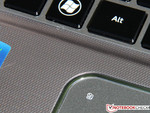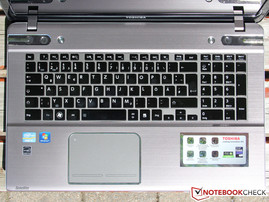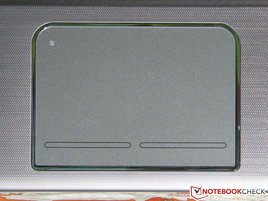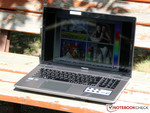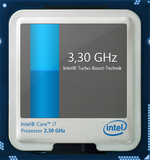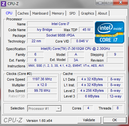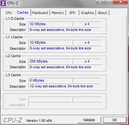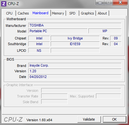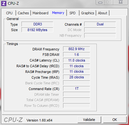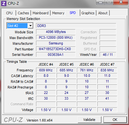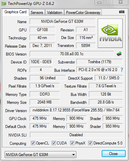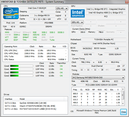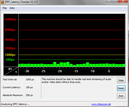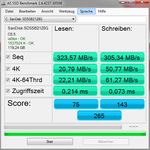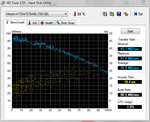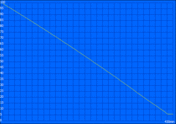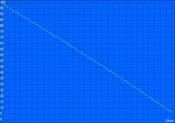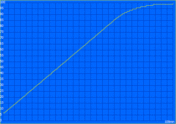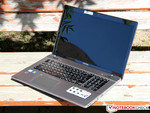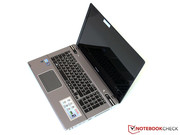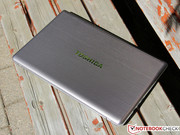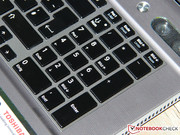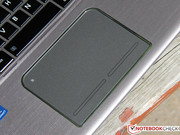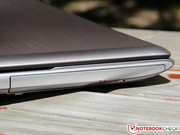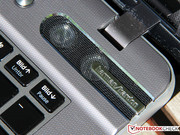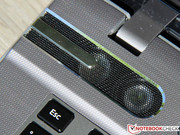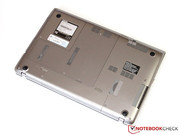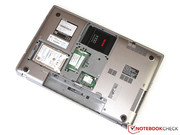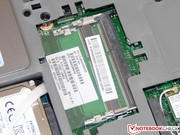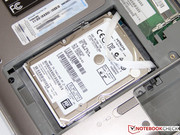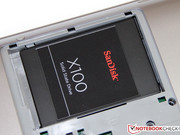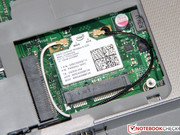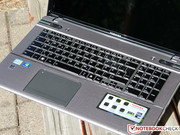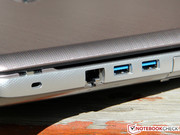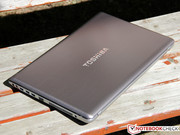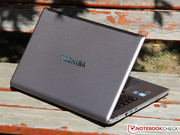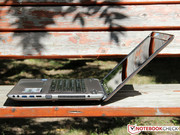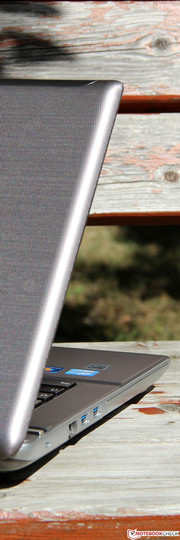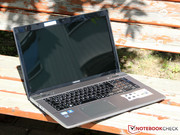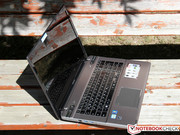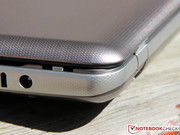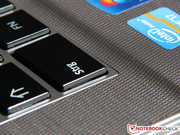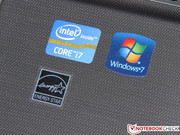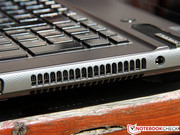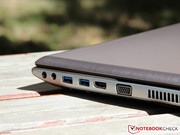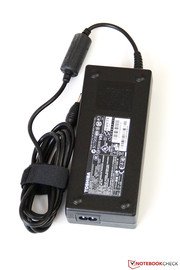Review Toshiba Satellite P875-30E (P870-30E) Notebook

There isn’t really a dearth of laptops catering to the crowd whose main purpose is media consumption. Every manufacturer has something in every price band – from the cheapest entry level laptop to the loaded premium devices at the top end of the spectrum. No buyer is left without an option.
Toshiba's Satellite P870-30E belongs to the premium price bracket by virtue of its price. Yes it does offer a great package when it comes to hardware – a quad core i7-3610M processor, 8 GB of RAM, a Blu Ray drive and 878 GB (750 GB HDD + 128 GB SSD) of storage space. Nvidia’s GeForce GT 630M is the GPU of choice. But having a 17.3-inch WXGA++ display in a laptop being sold for such a lot of money is disappointing. But buyers looking to get the device should pick up the machine without the SSD which should bring down the price to 1000 Euro (~$1250).
We picked Asus' N76M and Samsung's 550P7C from the giant list of rivals that are gunning for the top spot in this crowded space. This review will see how the laptop performs in comparison to the others.
Case
As usual, we start our review with a look at the case. Toshiba opted for a fashionable black and silver combination that gives the laptop an elegant, though somewhat boring look. Lightly textured surfaces provide a pleasant feel and prevent dust and fingerprints. The screen's glossy bezel is an exception and quickly proves to be impractical in everyday use.
The Satellite P875 makes a rather fragile impression for a 17-inch device. The thickness of less than 3.4 cm (~1.34 in) even undercuts some 15-inch laptops. Moreover, it weighs just over 3 kilograms (~6.6 lb.). However, its footprint (417mm x 272mm) is a bit bigger than Samsung's 550P7C. This is due to the Toshiba notebook's wider bezel (16 mm on the sides).
A material mix of aluminum and plastic ensures sufficient stability. Overall, the chassis convinces with its good resistance to selective pressure but exhibits minor shortcomings in typical problem areas like the region above the optical drive and battery. The display lid is held by two very stiff hinges and hardly wobbles. But the lid could have been a bit more rigid.
We can particularly praise the exemplary build that hardly shows weaknesses even when looked at closely. Rounded case edges and flush material transitions reinforce the high-end impression that we have come to expect from a laptop of this price range. However, the Satellite P875 cannot keep up with Asus' N76VM, but does outdo the Samsung's 550P7C.
Connectivity
USB 3.0 should not be omitted in any modern laptop and the manufacturer builds in a total of four. Two of these ports support Toshiba's "Sleep and Charge" function which enables recharging USB devices such as MP3 players or smartphones when the laptop is switched off. There are no older USB 2.0 ports meaning fast flash drives and other USB 3.0 devices can be connected to any one of the ports without loss of speed.
In addition to the usual VGA and HDMI sockets, we would have appreciated a DisplayPort for rendering movies from the integrated BD drive to monitors with more than 1920x1080 resolutions. Although HDMI would, in principle, be capable of higher resolutions, there are currently not many monitors that enable transmitting 1440p or 1600p via interfaces other than the DisplayPort (or dual-link DVI).
Apart from a few minor details, we are quite happy with Toshiba's interface distribution. The USB ports are grouped in pairs on both sides of the case and thus enables the best possible cable-routing for both left-handed and right-handed users. Infrequently used interfaces, such as Giga Bit LAN and the Kensington lock are located further back on the chassis while the card reader (at the front) and audio jacks (right) are closer to the user. The manufacturer even designs the gaps between the ports to be big enough so that broad USB flash drives do not obstruct neighboring ports.
Communication
The Satellite P875 connects to the Internet via Intel's Centrino Wireless-N 2230 supporting the standard IEEE 802.11 b/g/n. The low-end model unfortunately only supports connections to the 2.4 GHz band. Only the Advanced-N models support the 5 GHz band. At least the user can take advantage of gross transfer rates of up to 300 MB/s owing to dual-stream technology. However, we could only record 72 MB/s in our test (could be due to our router). The range and stability make a good impression.
Besides Wi-Fi including features like Wireless Display, the mini-PCIe module also supports the latest Bluetooth 4.0 version. UMTS is neither offered for the notebook nor can it be upgraded by the user.
The built-in webcam's quality is not unimportant for a multimedia device. It is one of the poor quality ones we have seen in such an expensive device. The 1.0 MP sensor features a maximum resolution of 1280 x 800 pixels and only provides moderately focused and slightly noisy pictures. The corresponding microphone is a bit muffled but does a good job with VoIP programs like Skype.
Accessories
The accessories that are included in the package are the ones that are needed to run the laptop. In addition to the device itself, you will find a bulky 120 W PSU, the battery and a quick start guide. The user has to create a recovery DVD.
But, the preinstalled software bundle is much more extensive. In addition to quite a few useful tools like the Nero Express Essentials burning program, various trial versions and adware are found among them. Although they can all be deleted, they are simply annoying.
Maintenance
A small rubber cap conceals a screw that secures the laptop's maintenance cover. The cover can be levered away carefully after the screw has been removed. Inside, there are two 2.5-inch slots which are occupied in the P875-30E. The manufacturer provides an additional mSATA slot over the Wi-Fi module that can be equipped with another SSD.
Upgrading the working memory is just as easy. The Satellite has a total of 4 slots. However, the user can only access two of them without further disassembly (2x 4 GB internal). The memory can be upgraded to a total of 16 GB when 4 GB modules are used, and up to a maximum of 24 GB using 8 GB modules.
Warranty
Toshiba provides a 2 year manufacturer's warranty ex-factory. Various retailers offer optional service bundles. An additional year costs 55 Euro/$70 (pick-up service) or 85 Euro/$110 (on-site service).
Input Devices
Keyboard
The Satellite P875 features a chiclet keyboard including a number pad that surprises with a few peculiarities at first. The F-functions have to be triggered by simultaneously pressing the FN key. This can be disabled in the BIOS. Various deviations in the layout like the rather short space bar need a bit of familiarization in the beginning.
Both positive and negative characteristics are noticed when typing. While we appreciate the optional backlight and the well-balanced, medium pressure point, some keys annoy us because they yield marginally and generate a clatter. The keys have the dimensions of 15 mm x 15 mm and an absolutely even surface which sometimes hinders accuracy.
Touchpad
The touchpad's size does not give reason for complaint. Its dimension of approximately 11 cm x 8 cm should be enough for even big hands. The input surface is a good balance of feel (lightly textured surface) and good gliding traits, which enables above-average user experience but precise mouse control. Various multi-touch gestures and other features like the palm sensor can be customized in the Synaptics driver panel. It is a bit strange that the pad hardly responds to user inputs when the CPU is fully loaded. The cursor then only jerks across the screen. We did not observe this problem when using an external mouse.
The mouse keys incorporated in the touchpad coil a bit and are fairly stiff. Clicking could be a bit more exact, but most competitors hardly do a better job due to similarly built inputs. We would prefer conventional, dedicated keys like the ones installed in Samsung's 550P7C.
Display
Despite the installed BD drive and the ability to render high-definition movies, Toshiba opted against a Full HD screen. The user has to be content with a WXGA++ screen with a resolution of 1600 x 900 pixels instead. However, the graphics card should be able to cope with this resolution.
The screen's brightness also does not fulfill the expectations that we place on a 1200 Euro multimedia laptop. An average of 217 cd/m2 should suffice for most routine situations, but better numbers would enhance the readability, particularly in bright surroundings.
| |||||||||||||||||||||||||
Brightness Distribution: 87 %
Center on Battery: 229 cd/m²
Contrast: 210:1 (Black: 1.09 cd/m²)
51% AdobeRGB 1998 (Argyll 3D)
65.6% sRGB (Argyll 3D)
49.21% Display P3 (Argyll 3D)
A look at the measured contrast (210:1) and black value (1.09 cd/m2) rates confirm our guess that the AUO B173RW01 V3 screen is a generic TN display. The Satellite P875 cannot compete against the Asus N76VM. The reflective surface at least gives an impression of better picture quality than it really is.
Being a consumer device through and through, our test sample is not made for the needs of professional graphic designers or photographers. The P875 just falls short of covering the sRGB color space and clearly fails in making an impact on the AdobeRGB space. You will not notice this drawback if you occasionally view or edit vacation pictures, especially since only a small number of laptops do a much better job.
Outdoor use is not on the table for a 17-inch device. In addition to higher brightness, an AR-coated screen (like the one in the Asus and Samsung devices) would be necessary to work with the laptop in bright sunlight. However, the user is bothered by intense reflections and is forced to sit in the shade or even go back indoors.
A movie night with friends is possible with the Toshiba. But the picture quality visibly worsens from wide viewing positions. The more you deviate from normal, the weaker the contrast gets. As typical for TN screens, vertical viewing angles are extremely limited though there still is certain degree of elbowroom horizontally. Again, Asus' N76VM proves that screens based on TN technology can be better.
The analog VGA out is close to extinction but is still needed for connecting older projectors and monitors in some cases. The output from the VGA port is very good and is very similar to the output of the HDMI port.
Performance
Four cores and 8 threads via Hyper Threading, a 6 MB cache and a 2.3 GHz base clock (Turbo up to 3.3 GHz) are the Core i7-3610QM's key specs. The fast processor is one of the most popular models from the Ivy Bridge range and is built using the cutting-edge 22 nanometer process. The TDP of 45 watts is 10 watts higher than in the dual-core i3 and i5 series CPUs. However, they are not available for the Satellite P875. Detailed specifications and additional features of the 3610QM can be found in our CPU database.
The manufacturer opted for Nvidia's GeForce GT 630M graphics card, which is a low performance GPU placed towards the lower half of the table. Together with Optimus technology for dynamic graphics switching, the card is only enabled when games or other 3D applications require its performance capabilities. The integrated Intel HD Graphics 4000 is responsible for graphics support in routine use.
Toshiba equips the Satellite with up to 16 GB of working memory depending on the configuration. Our P875-30E has to be content with "only" 8 GB (2x 4 GB DDR3-1600), which will satisfy most users. Moreover, the device sports a conventional 750 GB hard disk as well as a fast 128 GB SSD. However, the latter is only installed in specific models.
Processor
The P875 finishes our CPU benchmarks without irregularities and achieves the performance rates expected from such a hardware configuration. This is by no means a matter of course since not every modern laptop is able to remain free from throttling on battery power and exploit the maximum Turbo Boost capacity completely. We accomplished 6.2 points in Cinebench R11.5 (64bit) multi-thread test and 1.38 points in the single-thread benchmark which are excellent scores for the i7-3610QM. No matter whether sophisticated video editing or the latest game, the user will not be able to complain about the processor's lack of power at any time.
Storage Devices
The bulky 17-inch chassis offers room for two full-fledged 2.5-inch hard disks and which can be installed by the user.
The system partition is stored on a 128 GB SSD from SanDisk (SD5SB2128G). Consequently, 100 GB remains for Windows and other programs after deducting space for the recovery partition. Larger applications should therefore be installed on the additional 750 GB hard disk (Hitachi HTS54757A9E384).
Although SanDisk's SSD cannot compete with faster drives (Samsung PM 830, Crucial M4), it supplies a decent performance boost compared with every HDD. The sequential read and write speeds are both approximately 300 MB/s and do not drop much even with smaller sized files.
A mechanical hard disk cannot reach these speeds. An average of 75 MB/s and an access time of 18.4 milliseconds are normal for a 5400 rpm model and also sufficient for a data drive.
System Performance
Both Asus' N76VM and Samsung's 550P7C participate in our tests without an SSD, so it should be easy for Toshiba to outdo both contenders in the memory-heavy PCMark benchmarks. And it does so by a huge margin. With 14223 points in PCMark Vantage and 3936 points in PCMark 7, the Satellite P875 surges to the top and leaves the SSD-less competition behind with gains of 50 percent.
The flash memory drive's advantage is often even bigger in routine use. This begins with extremely fast boots that hardly takes 20 seconds, including the POST screen, and continues with faster responsiveness to user input.
In view of the big price difference, tech-savvy users should consider buying a cheaper version of the P875 without the SSD and retrofitting one. This also applies to –its rivals, all 3 models offer room for a second drive, at least in principle (the 550P7C does not always include the necessary cable).
| PCMark Vantage Result | 14223 points | |
| PCMark 7 Score | 3936 points | |
Help | ||
Graphics Card
The GeForce GT 630M is an old acquaintance. The underlying GF108 chip has been installed in many multimedia laptops since 2010. Nvidia has now presented a refresh of the card scaled down to 28 nanometers (GF117 chip), but Toshiba still installs the older 40 nanometer version in its P875. Unfortunately, the manufacturer also omits the optional Turbo mode of the GeForce 600M generation and sets the core clock to 662 MHz (load). The 96 shader units clock at twice the frequency (1324 MHz) and the 2 GB DDR3 VRAM (128 bit) with 900 MHz in the Fermi card.
The new GeForce GT 650M (Kepler) model in Samsung's 550P7C blows away the GT 630M. The Satellite also lags behind the N76VM with the same GPU due to the lack of Turbo. The advantage of Asus' notebook is roughly 15 percent (1288 to 1123 points) in 3DMark 11. The graphics card's extreme throttling on battery power is common to both devices (3DMark 11: 319 points).
| 3DMark 11 - 1280x720 Performance (sort by value) | |
| Toshiba Satellite P875-30E | |
| Asus N76VM-V2G-T1078V | |
| Samsung 550P7C-S02DE | |
| 3DMark 05 Standard | 16151 points | |
| 3DMark 06 Standard Score | 8460 points | |
| 3DMark Vantage P Result | 4786 points | |
| 3DMark 11 Performance | 1123 points | |
Help | ||
Gaming Performance
The GT 630M is frequently too low in the performance stakes to render current games in maximum details and native resolution. A resolution of 1366x768 pixels is already too much for the graphics card in Battlefield 3 and Anno 2070 forcing the user to play the game with medium if not low settings. The GeForce GT 650M in the Samsung is almost twice as fast and the better choice for gamers. The Satellite P875 also lags behind the Asus N76NV again due to the omitted GPU Turbo which limits the performance significantly in this case.
| low | med. | high | ultra | |
|---|---|---|---|---|
| Deus Ex Human Revolution (2011) | 104.8 | 40.9 | ||
| Battlefield 3 (2011) | 35.7 | 23.8 | 17.8 | |
| Anno 2070 (2011) | 82 | 32.9 | 20.5 | |
| Diablo III (2012) | 104.3 | 65.5 | 57.2 |
Emissions
System Noise
The Satellite's fan ran constantly at idle due to the relatively high ambient temperatures during our test (approximately 25 degrees Celsius). The noise level of 32.5 dB (A) remained quite inconspicuous. However, the fan increased its speed occasionally even during light load reaching up to 34.8 dB (A) making the laptop clearly audible (from a normal seating distance).
The noise level increased even more during load and reached levels of 39.1 dB (A) (3DMark 06) and 43.3 dB (A) (during the stress test). Consequently, our test device was louder than the Asus and the Samsung which also struggle with throttling during full load. We will examine if this is the case in Toshiba's laptop in the following section.
Noise level
| Idle |
| 32.5 / 33.3 / 34.8 dB(A) |
| HDD |
| 32.5 dB(A) |
| DVD |
| 37.8 / dB(A) |
| Load |
| 39.1 / 43.4 dB(A) |
 | ||
30 dB silent 40 dB(A) audible 50 dB(A) loud |
||
min: | ||
Temperature
First, we take a look at the case temperatures. As long as the hardware is not loaded, the laptop remains exceptionally cool and hardly reaches an average of 30 degrees Celsius which is very likely due to the constantly running fan.
The temperature around the vent climbs to just below 50 degrees Celsius during full load conditions. Fortunately, the wrist rest is not affected and settles to about 30 - 39 degrees Celsius. Thus, long gaming sessions are no problem. The Satellite can still be used on the lap during normal workloads. We would however advise against that during full-load conditions.
Although the processor heats up in our stress test (99 degrees Celsius), we did not observe throttling. The Core i7-3610QM maintains its maximum Turbo clock of 3.1 GHz which is exemplary. GPU-Z only records a core temperature of 73 degrees Celsius on the graphics card running with stable clock rates.
(-) The maximum temperature on the upper side is 47.1 °C / 117 F, compared to the average of 36.9 °C / 98 F, ranging from 21.1 to 71 °C for the class Multimedia.
(-) The bottom heats up to a maximum of 49.5 °C / 121 F, compared to the average of 39.2 °C / 103 F
(+) In idle usage, the average temperature for the upper side is 29.2 °C / 85 F, compared to the device average of 31.3 °C / 88 F.
(±) The palmrests and touchpad can get very hot to the touch with a maximum of 38.8 °C / 101.8 F.
(-) The average temperature of the palmrest area of similar devices was 28.7 °C / 83.7 F (-10.1 °C / -18.1 F).
Speakers
The name Harman Kardon will be familiar to many readers. The US manufacturer has acquired a respectable reputation with its high-quality audio components, especially among Hi-Fi fans.
Premium sound quality cannot be expected from a laptop due to the lack of room. However, compared with other devices, the two-way stereo speakers are outstanding. The trebles and mid-ranges are each rendered by one speaker and two more are responsible for the bass. The speakers reproduce an extremely powerful sound despite their small size and even excel over some notebooks with an additional subwoofer. The relatively linear frequency response eliminates unnecessary distortions of high or low pitches and this certainly deserves praise. Movies, games and music are very enjoyable even without external speakers (connected via jack or HDMI) and also fill larger rooms with sound when required.
Battery Life
Power Consumption
The Satellite P875 power draw is quite modest for a 17-incher with merely 8.1 to 15.6 W when idling. Samsung's 550P7C is just as energy efficient but the Asus N76VM needs a few watts more.
We ascertained a comparatively low power draw of 64.6 W (average) in 3DMark 06, which seems appropriate for the laptop's good application and 3D performance. In return, the power consumption skyrockets during full load conditions (Furmark and Prime 95) and climbs up to 107.5 W. This sounds like quite a lot at first, but since we did not determine throttling, it is logical. Toshiba designs the 120 W PSU to be strong enough so that there should be no problems running the laptop on it.
| Off / Standby | |
| Idle | |
| Load |
|
Key:
min: | |
Battery Runtime
The battery with a capacity of only 48 Wh is fairly small and lowers our expectations on battery life. Even the manufacturer's optimistic specification only states a maximum of 4.5 hours.
The surprising thing is that the Satellite P875 almost mutates to an endurance machine when the BatteryEater Reader's test was run recording a decent 7 hours and 10 minutes (energy saving mode, minimum brightness, wireless modules switched off). Samsung's 550P7C lasted for just as long even though it had a bigger 57 Wh battery.
The user can also surf for over 4 hours on the Internet using the Wi-Fi. We use energy savings mode and set the screen brightness to approximately 150 cd/m2 (level 7/8) for this. It is possible to easily watch two average-length DVD movies on the Satellite.
The best energy-saving features do not help much during load. The small battery limits the runtime in BatteryEater's Classic test to a maximum of 53 minutes (high-performance, maximum brightness, wireless module on). A complete recharge is completed in less than 2 hours thanks to the strong PSU.
Verdict
If you are willing to invest 1200 Euro in a multimedia laptop, you will unlikely want to accept compromises. Our expectations on Toshiba's Satellite P875-30E were high and the lavishly equipped 17 inch behemoth could mostly fulfill them.
Excellent workmanship and decent stability distinguish the good looking and pleasant feeling aluminum / plastic chassis that harbors the high-performance hardware. The application performance is excellent owing to the quad-core processor and SSD drive. Even games are quite possible due to the presence of the GeForce GT 630M. There are of course cheaper laptops with faster graphics cards available, but compromises have to be made somewhere else. Toshiba focuses on multimedia use and created the best conditions by installing a BD drive and outstanding speakers.
Regrettably, the poor screen mars the overall impression. The brilliant, matt Full HD screen in the Asus N76VM would look very good in the P875 and even make the laptop suitable for outdoor use. The Satellite scores with its long battery life and low weight for a 17-inch device.
Now, the decision to whether buy Toshiba's Satellite P875 is a matter of personal preference. It basically earns it purchase recommendation as an elegant all-round machine which is not meant for gamers who will be happy with other alternatives like the Samsung's 550P7C.




